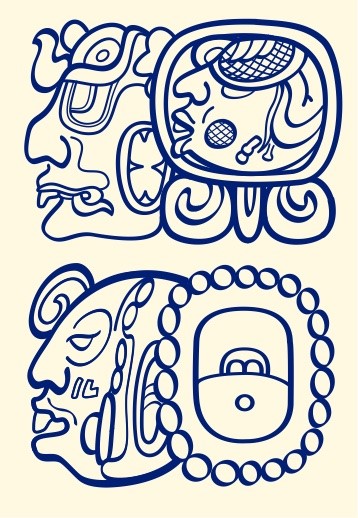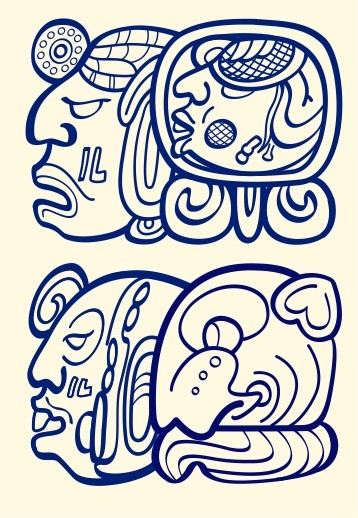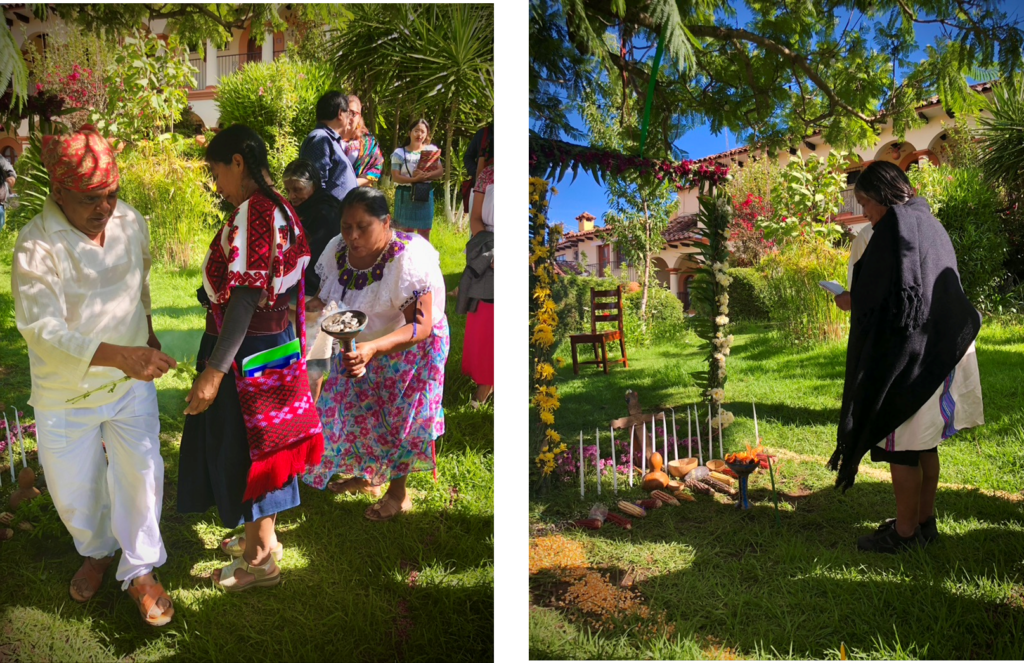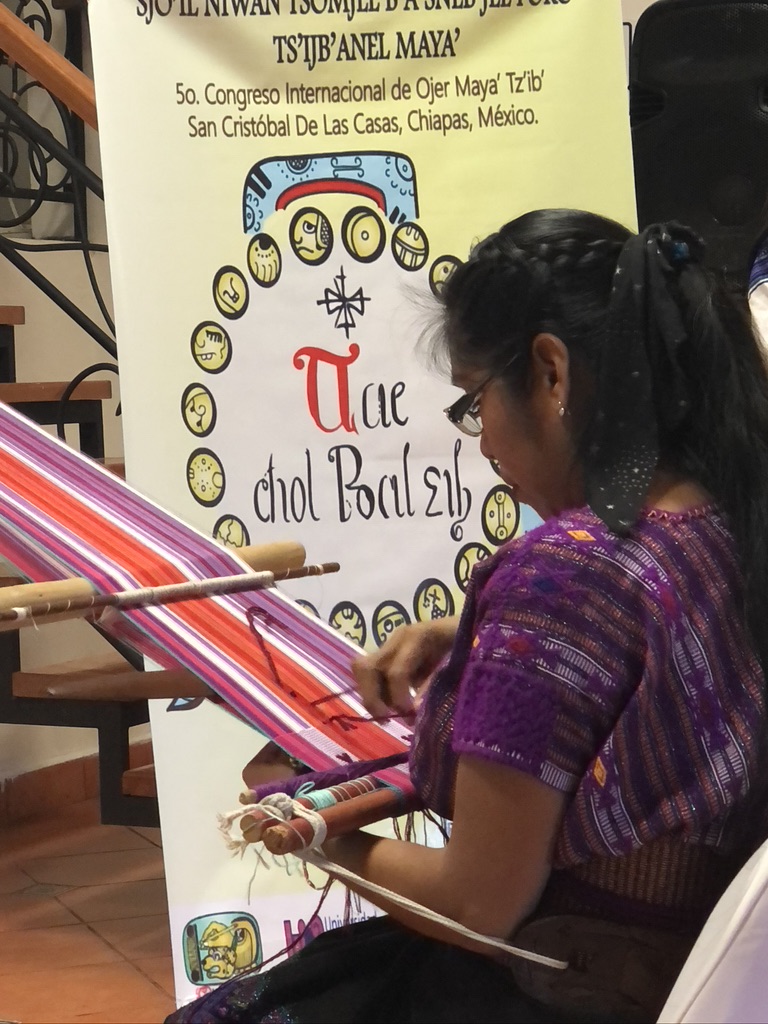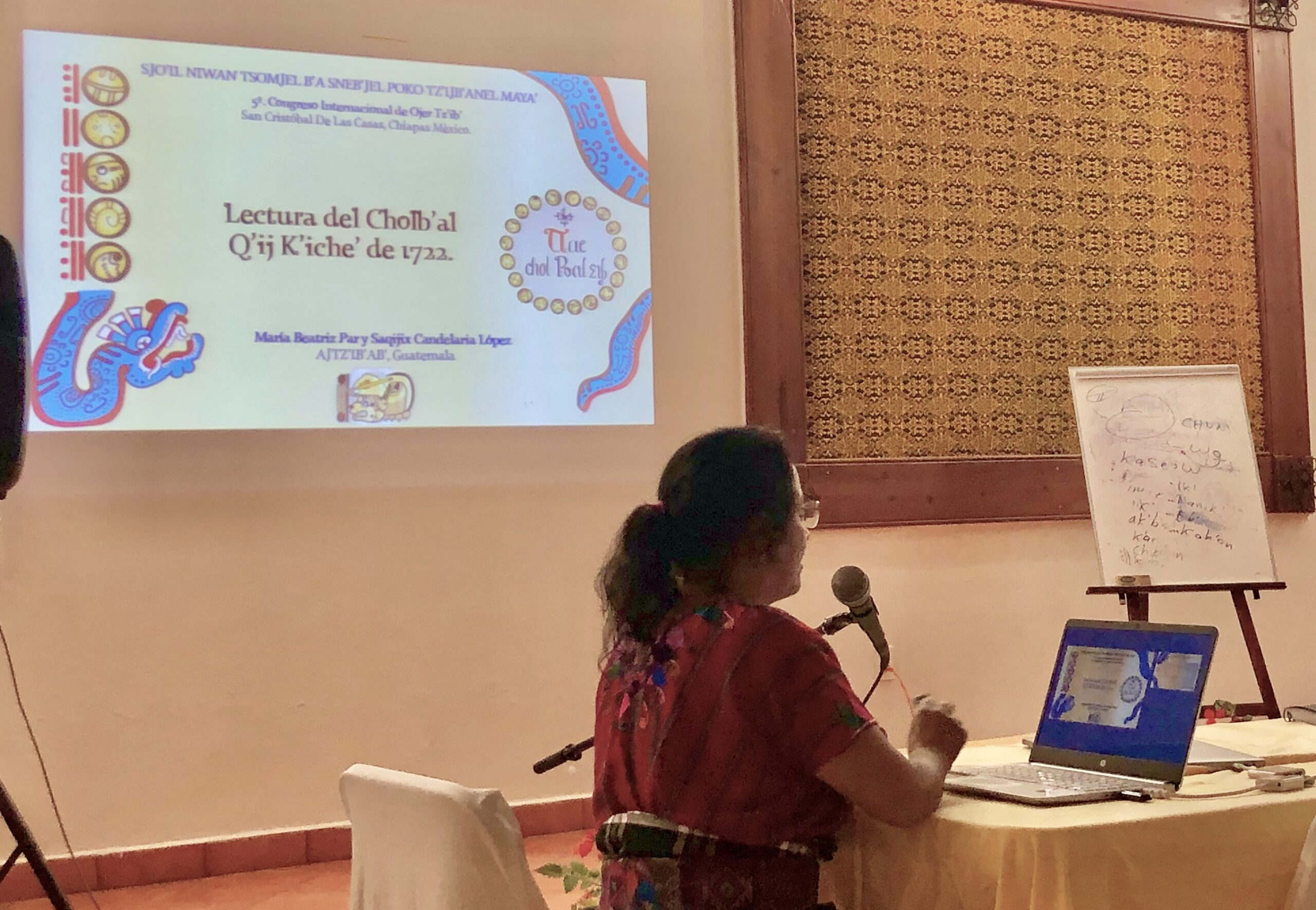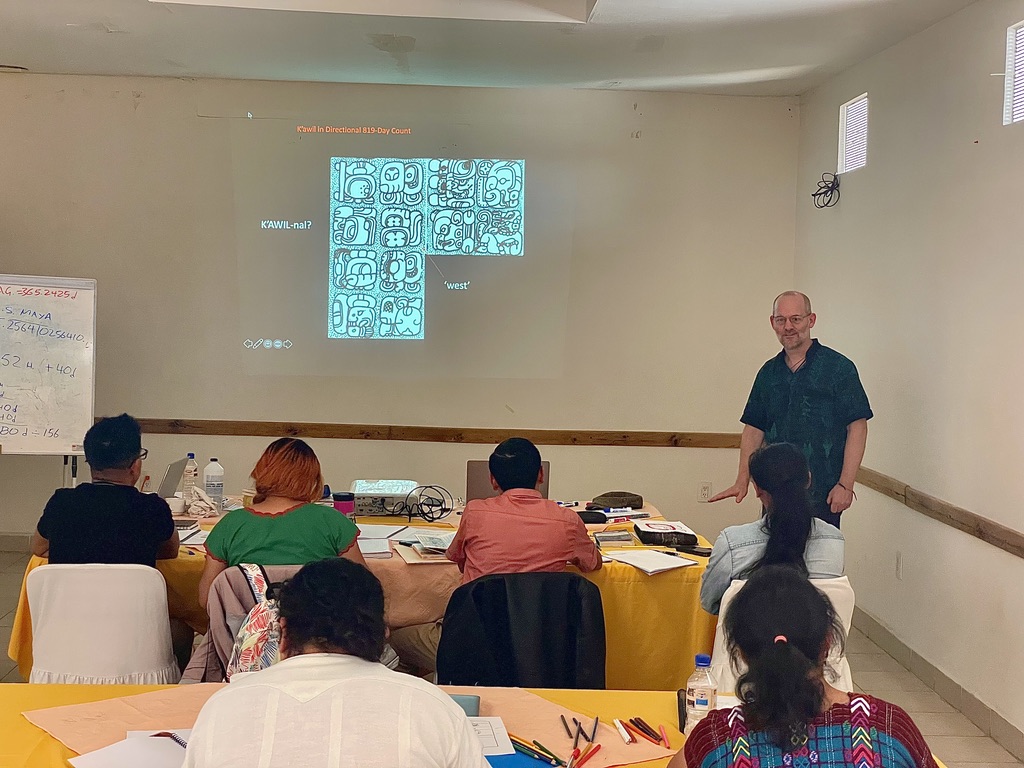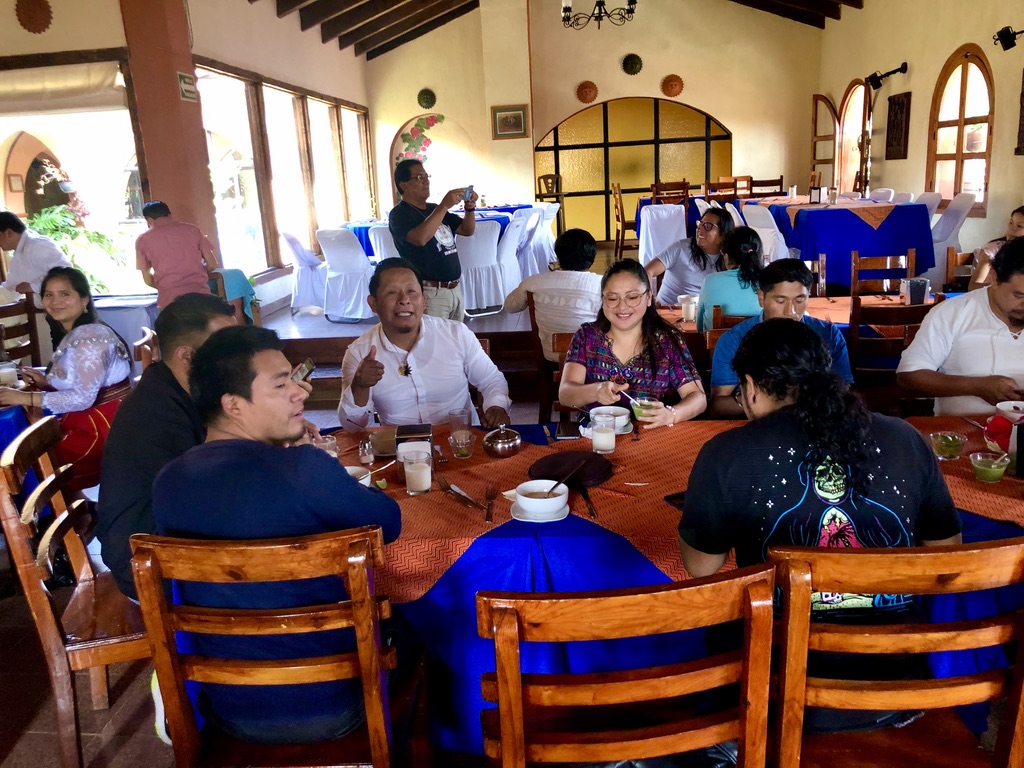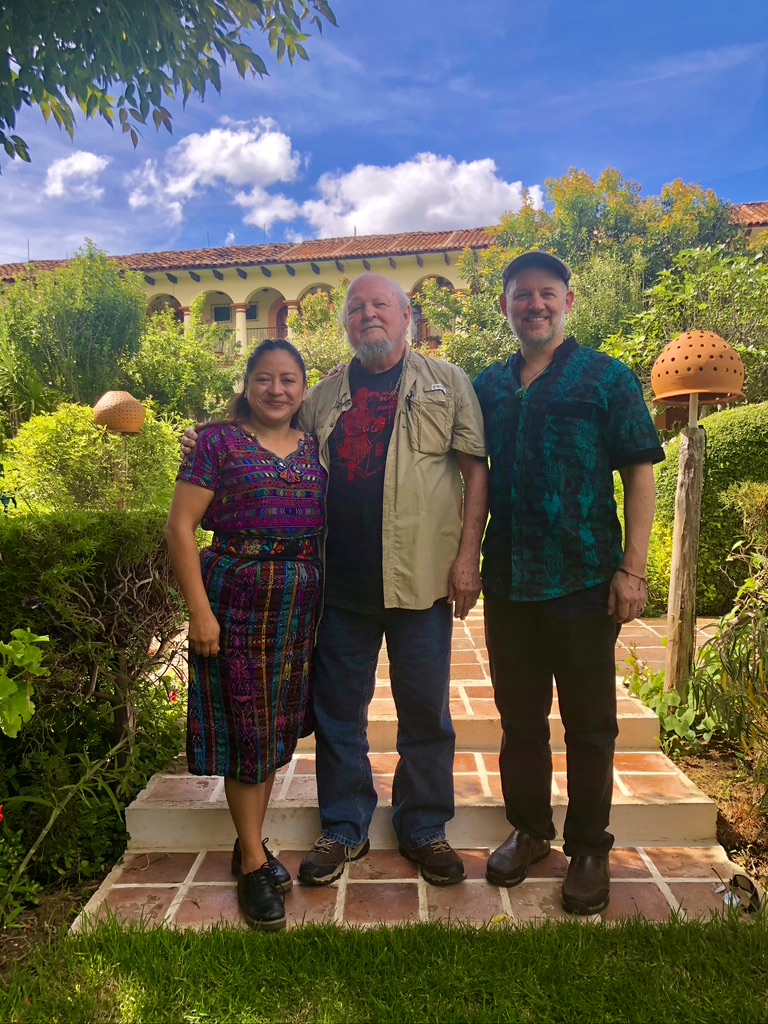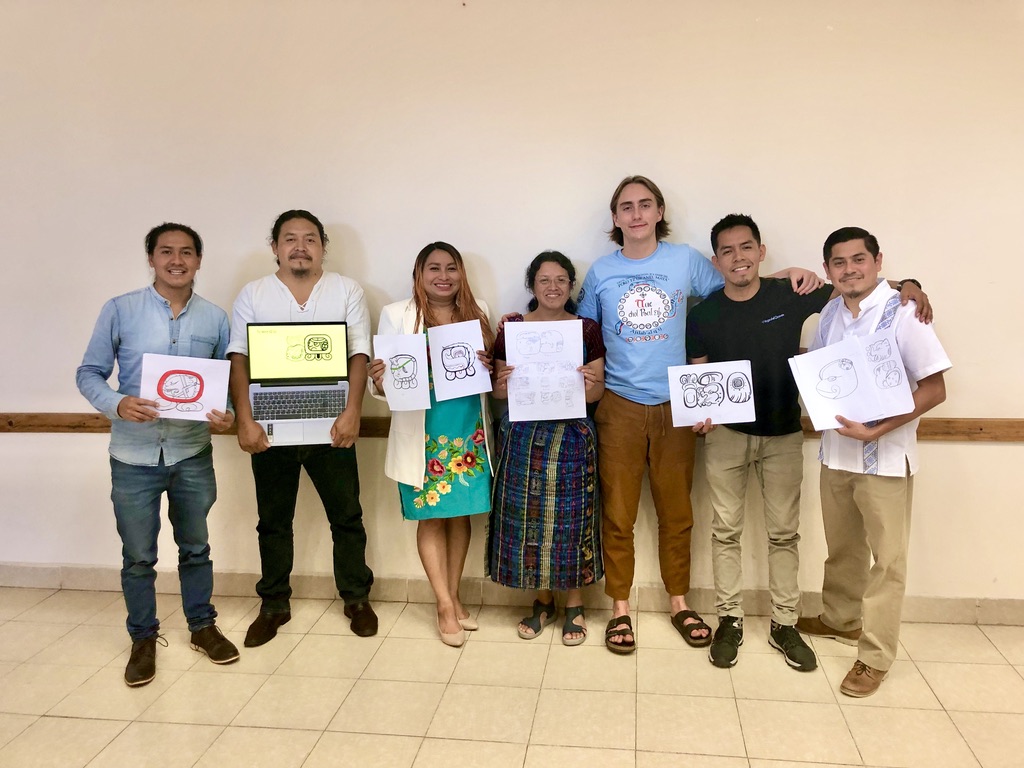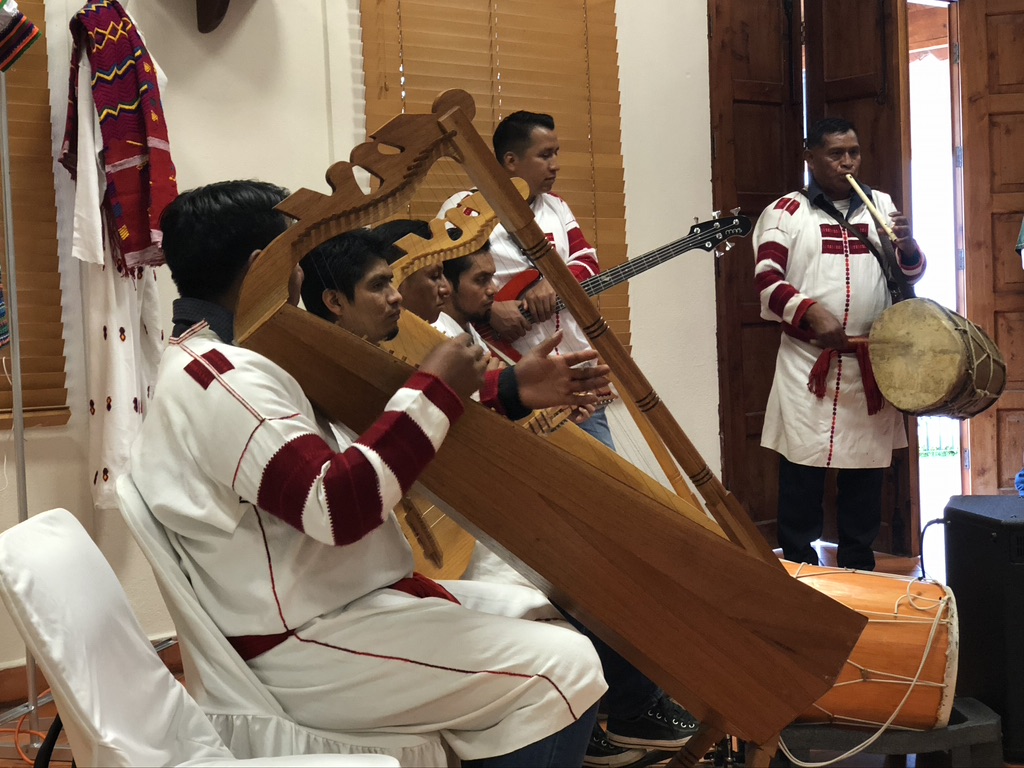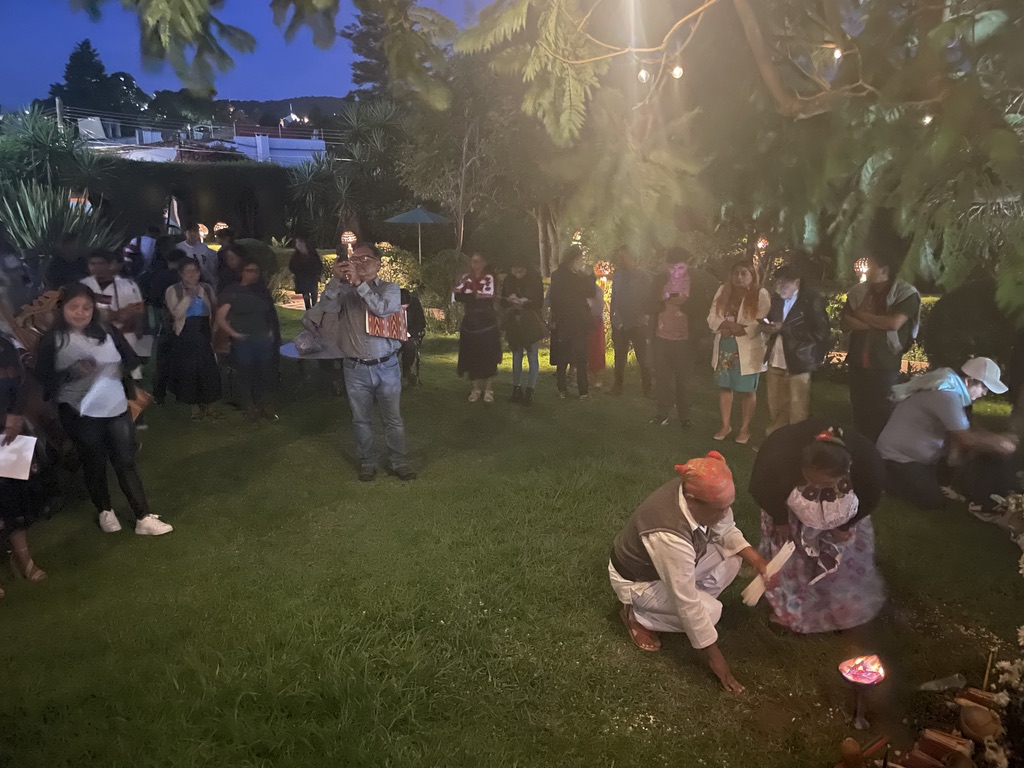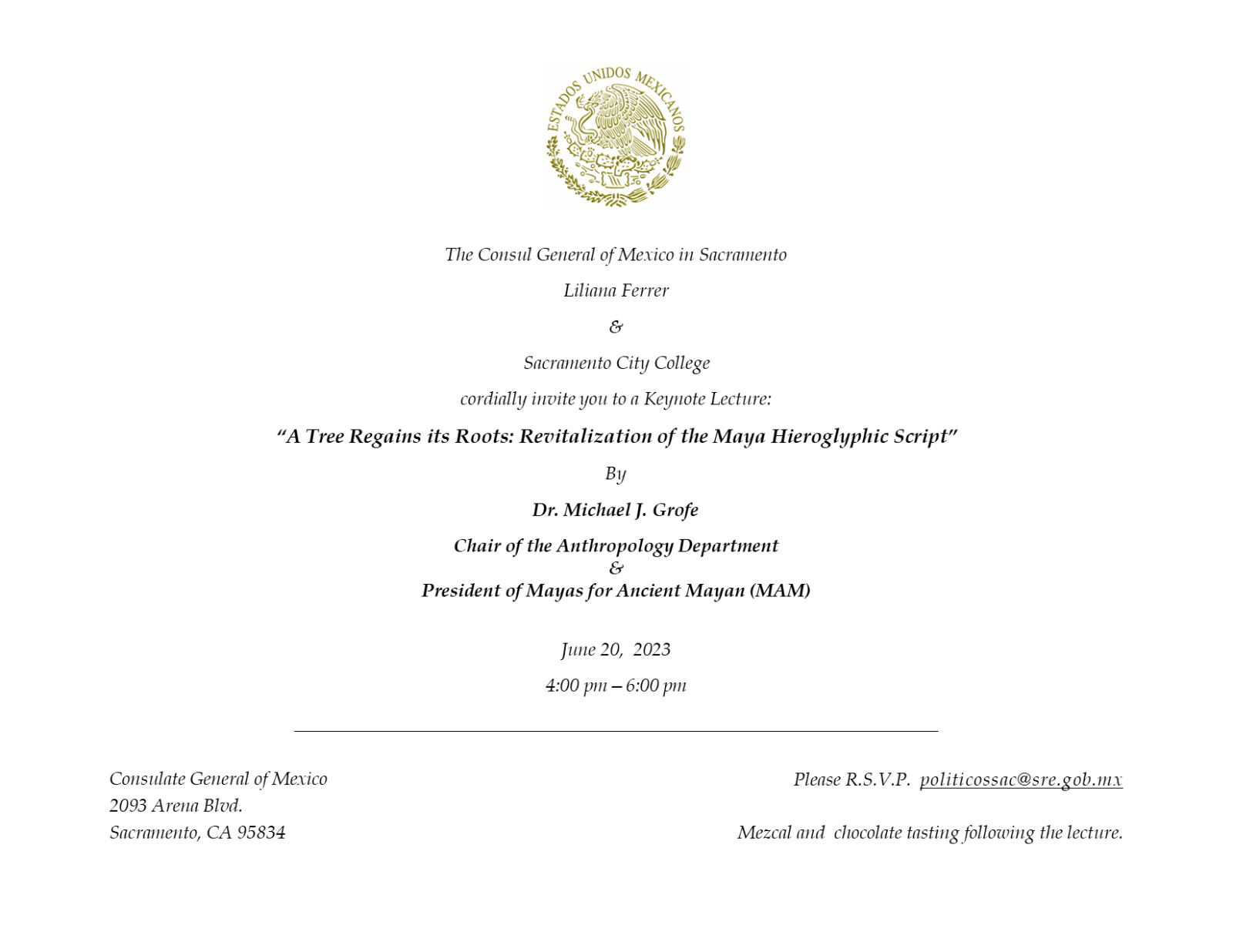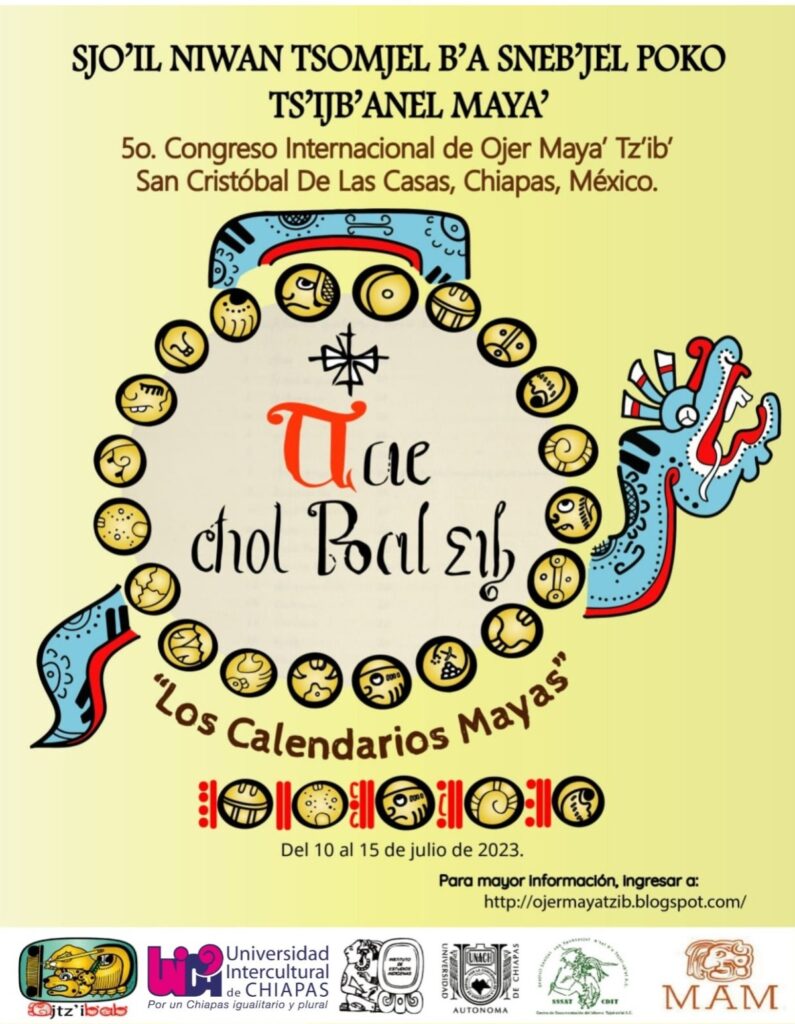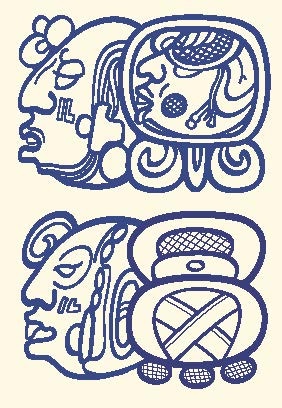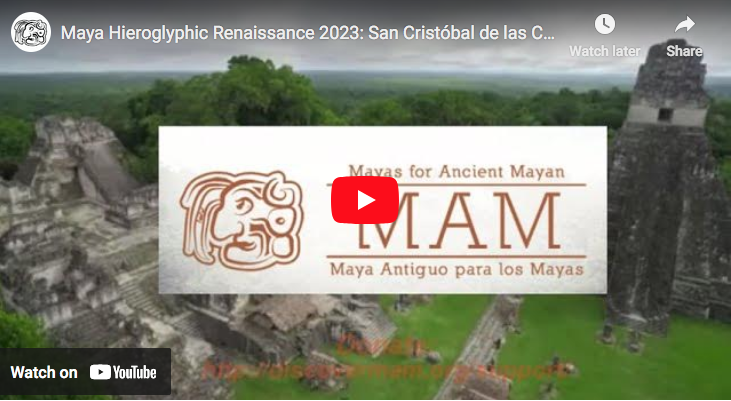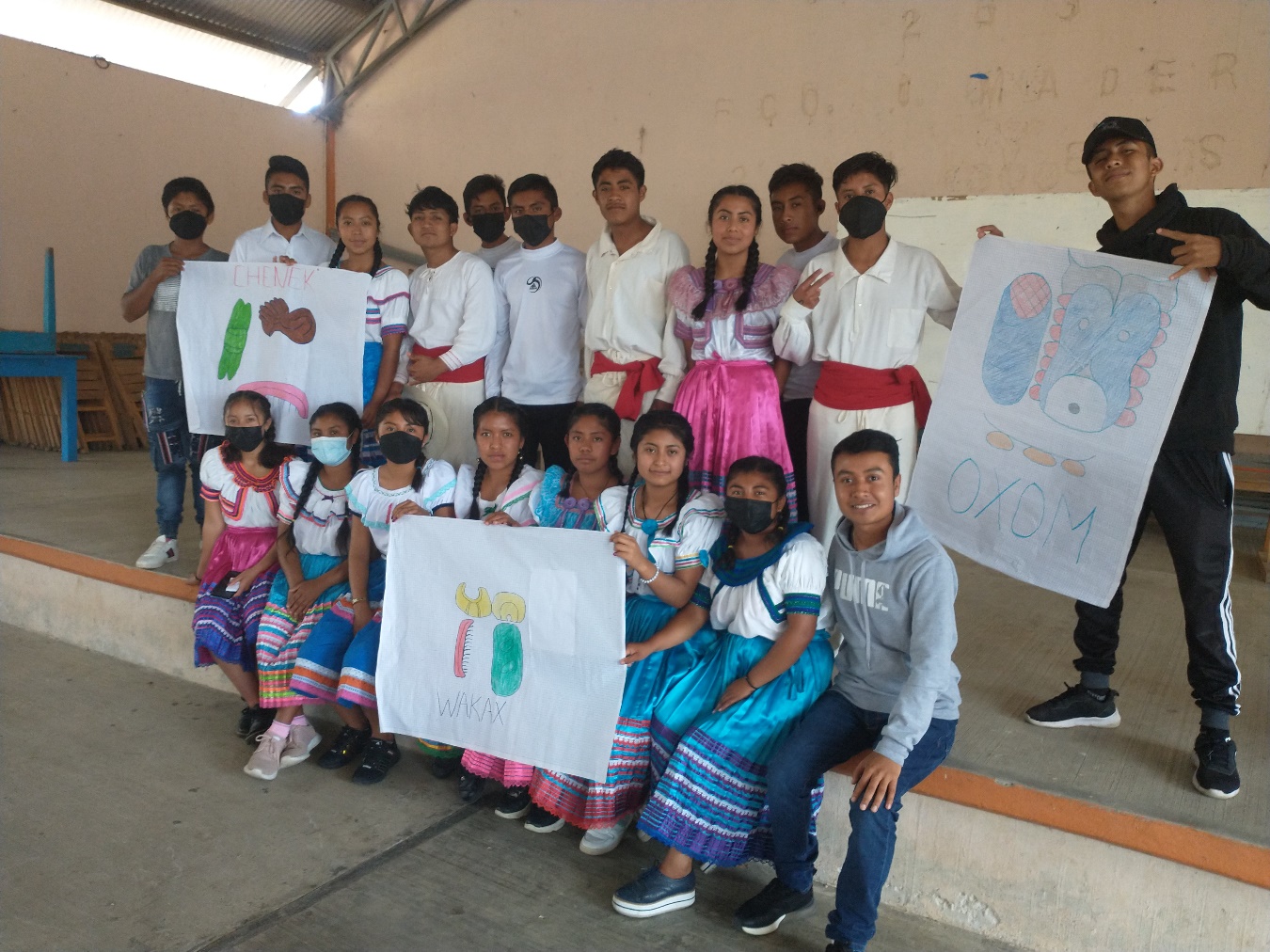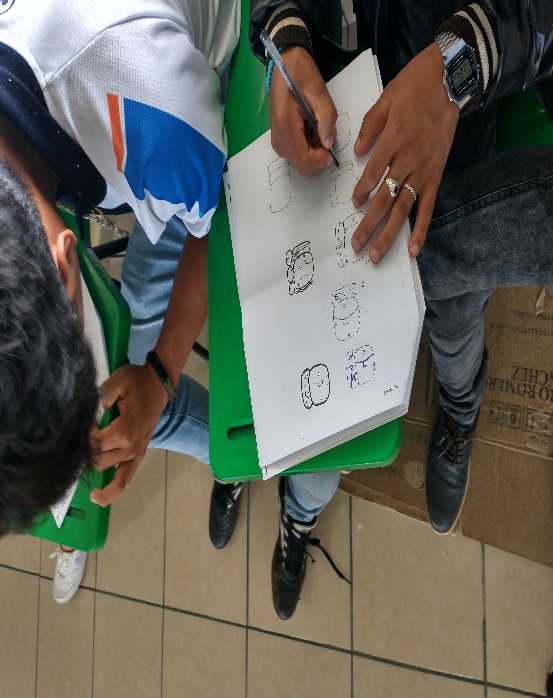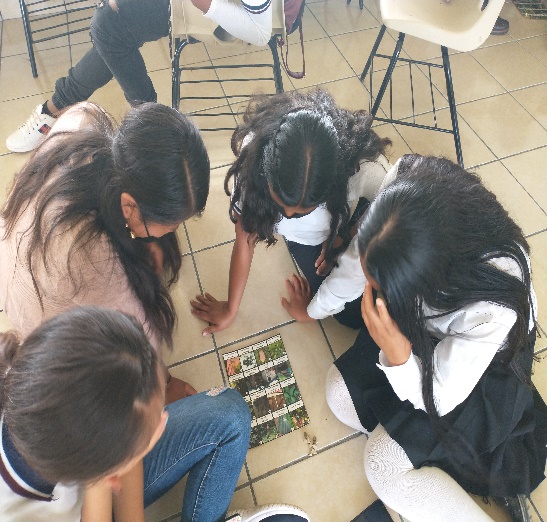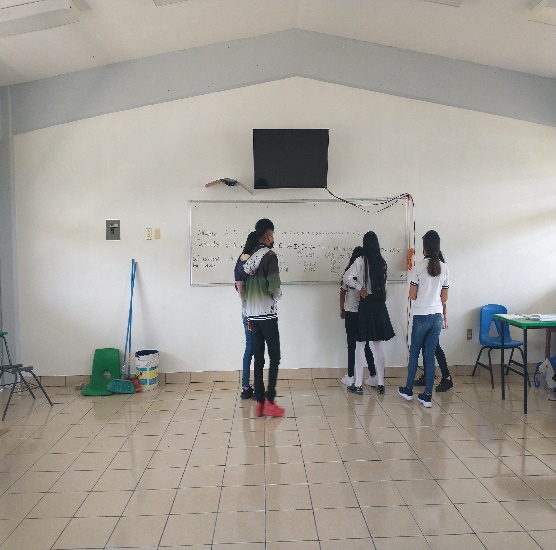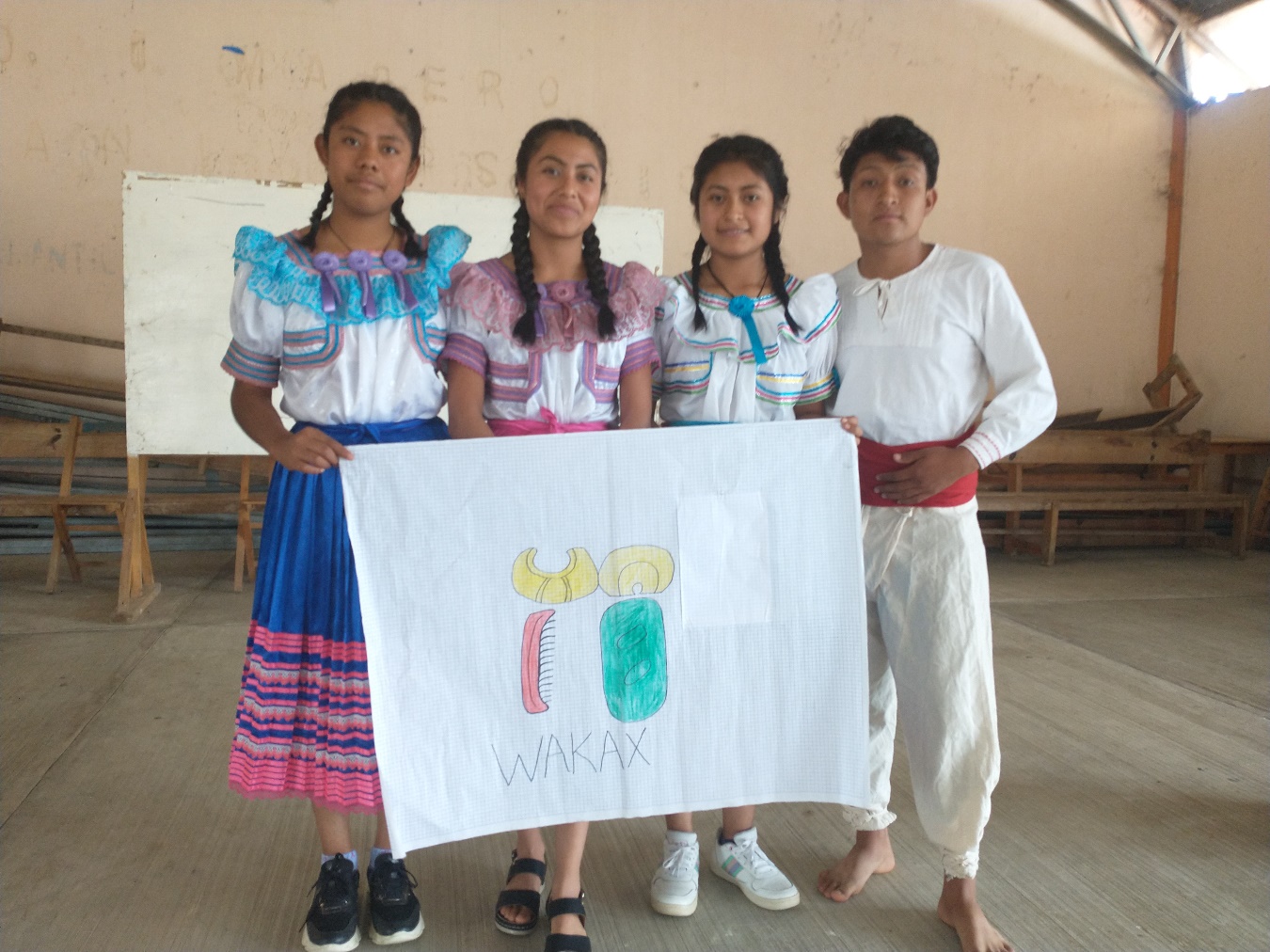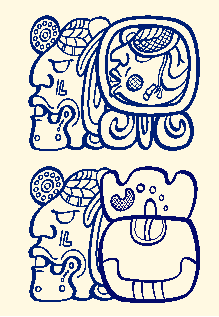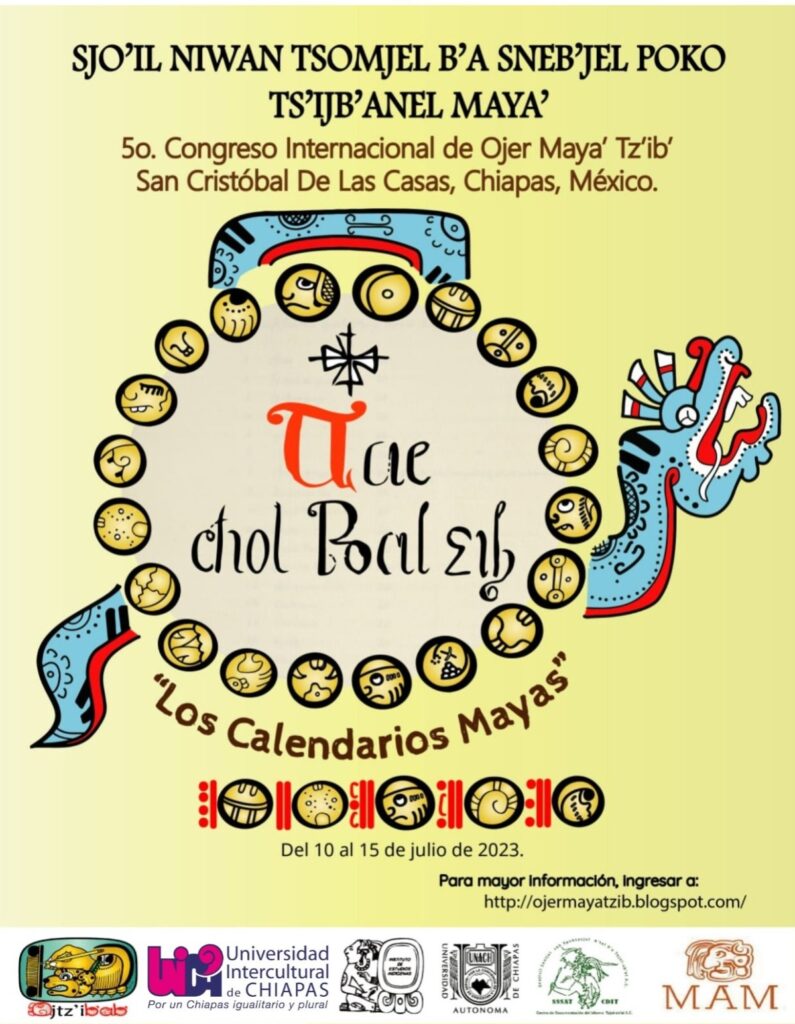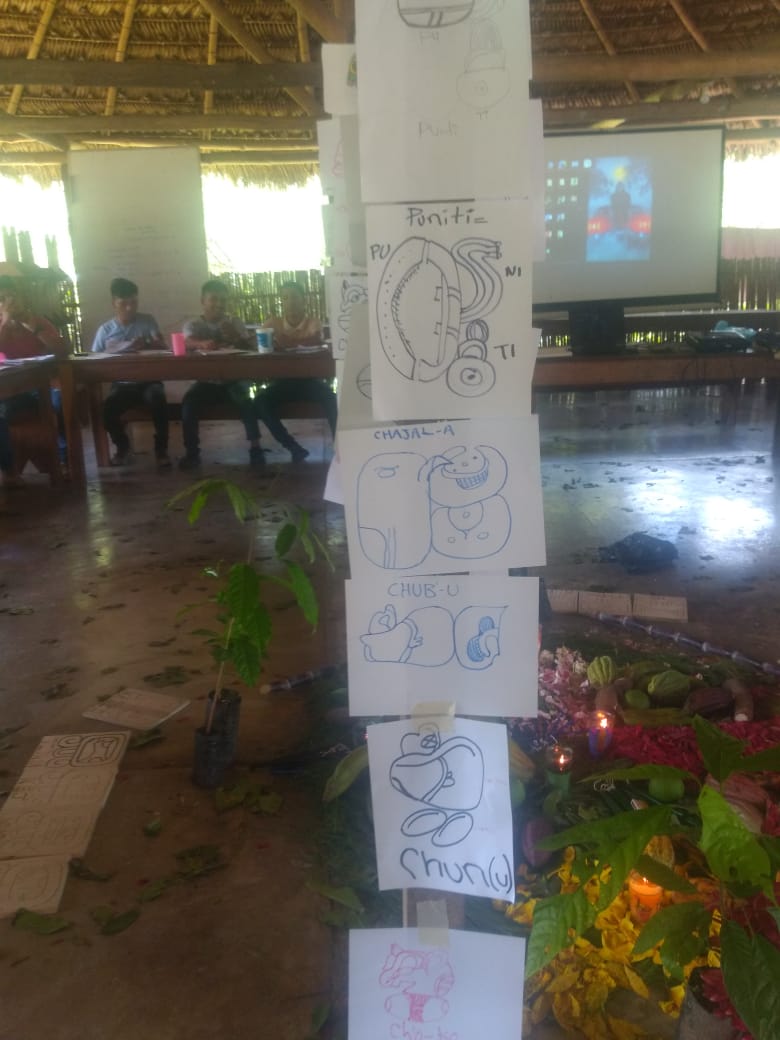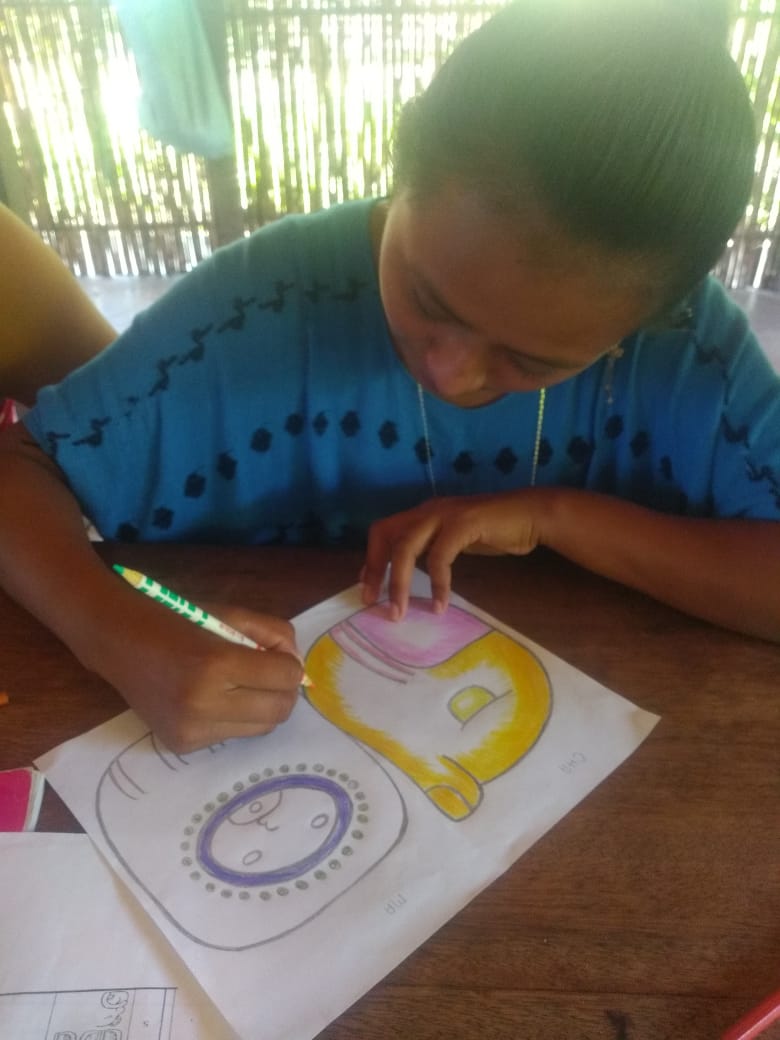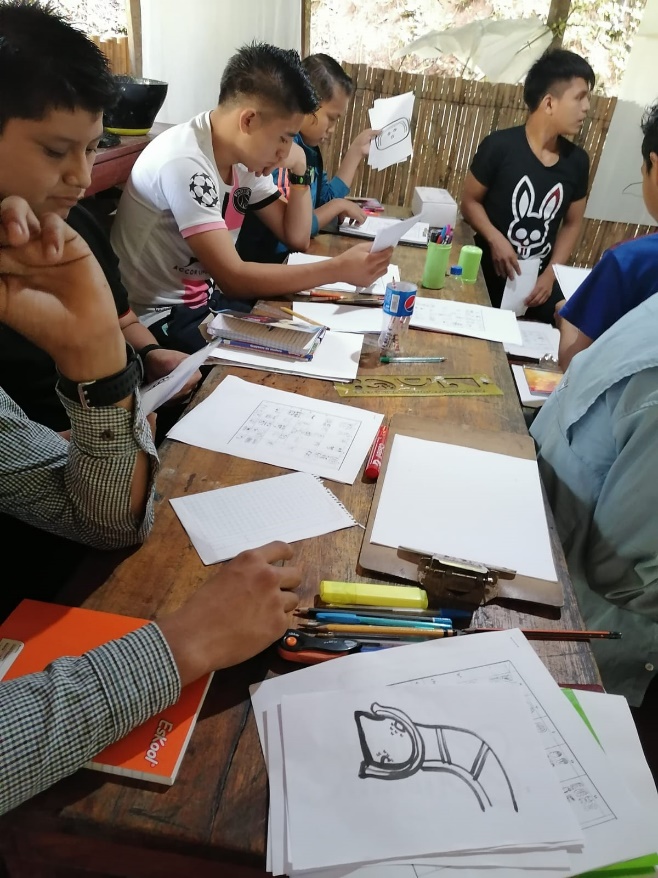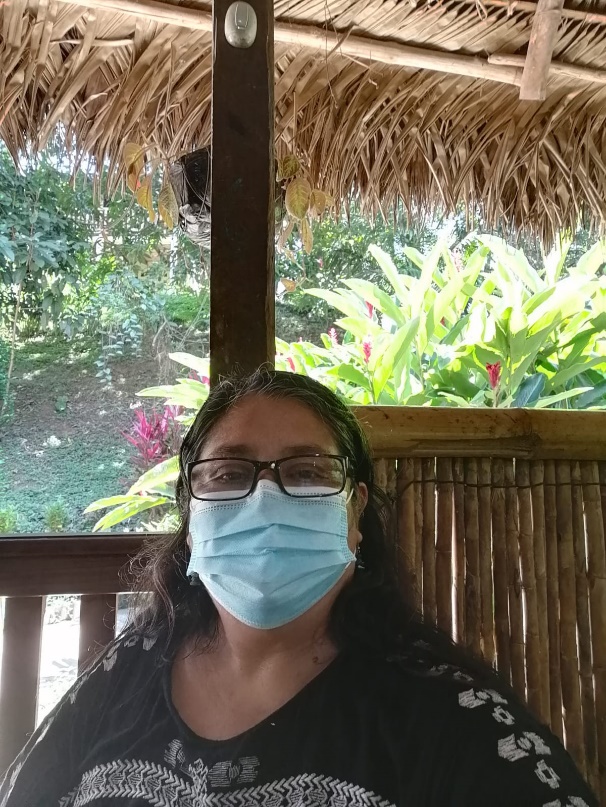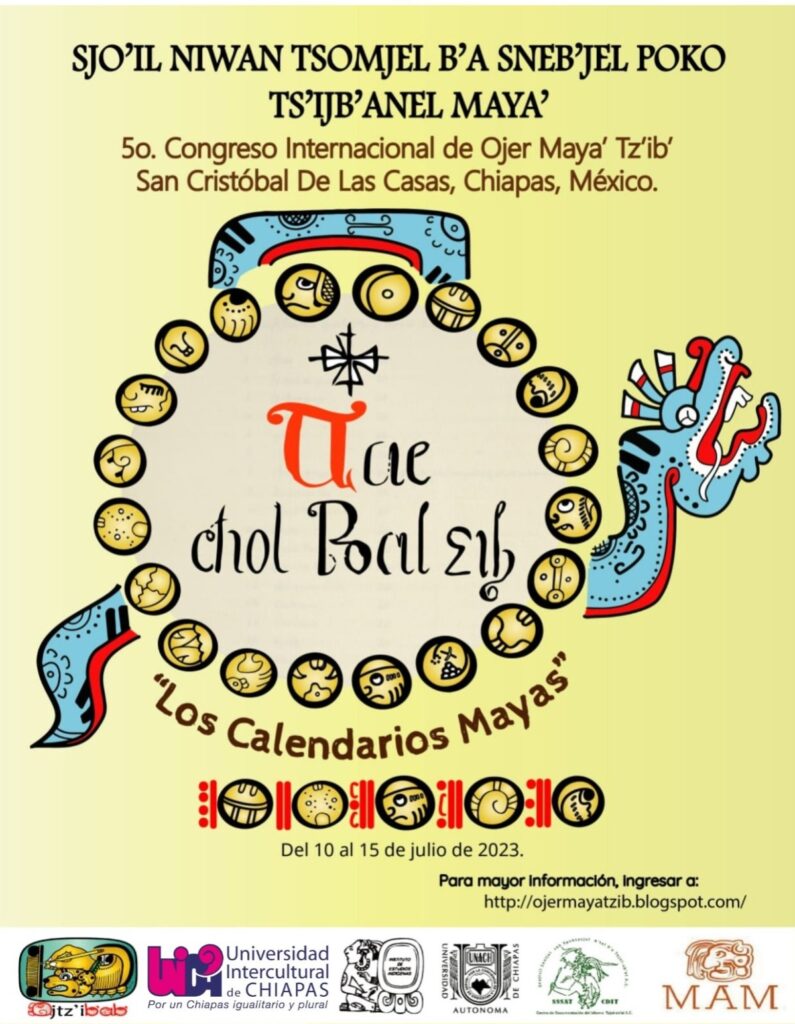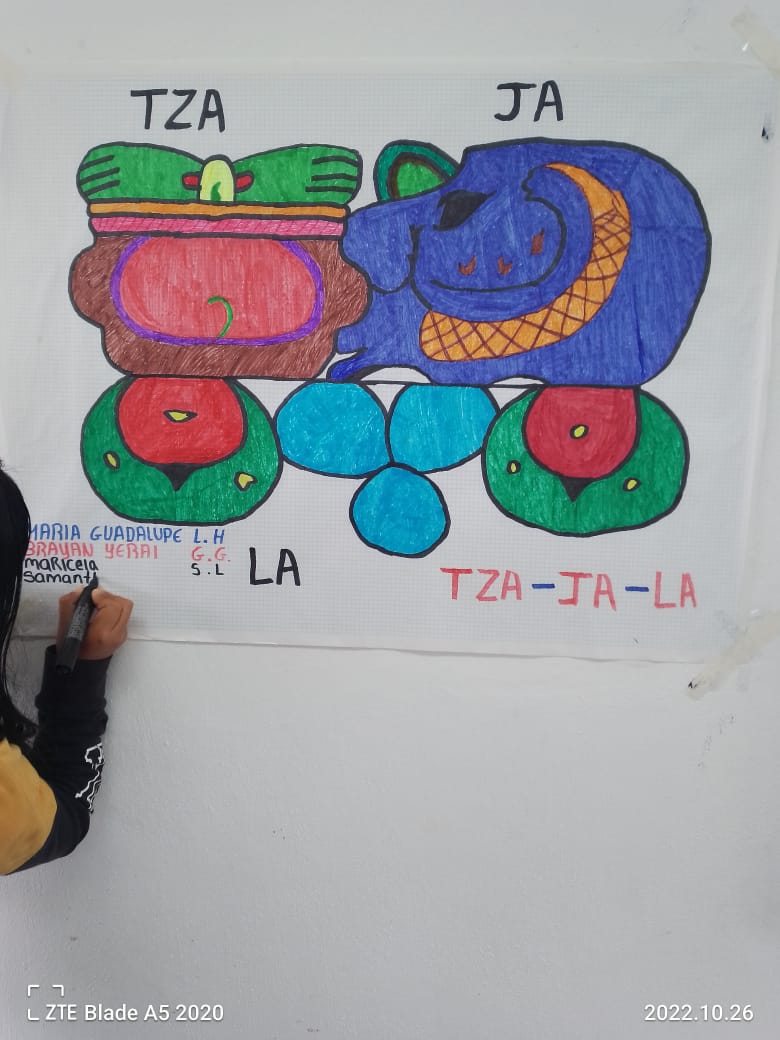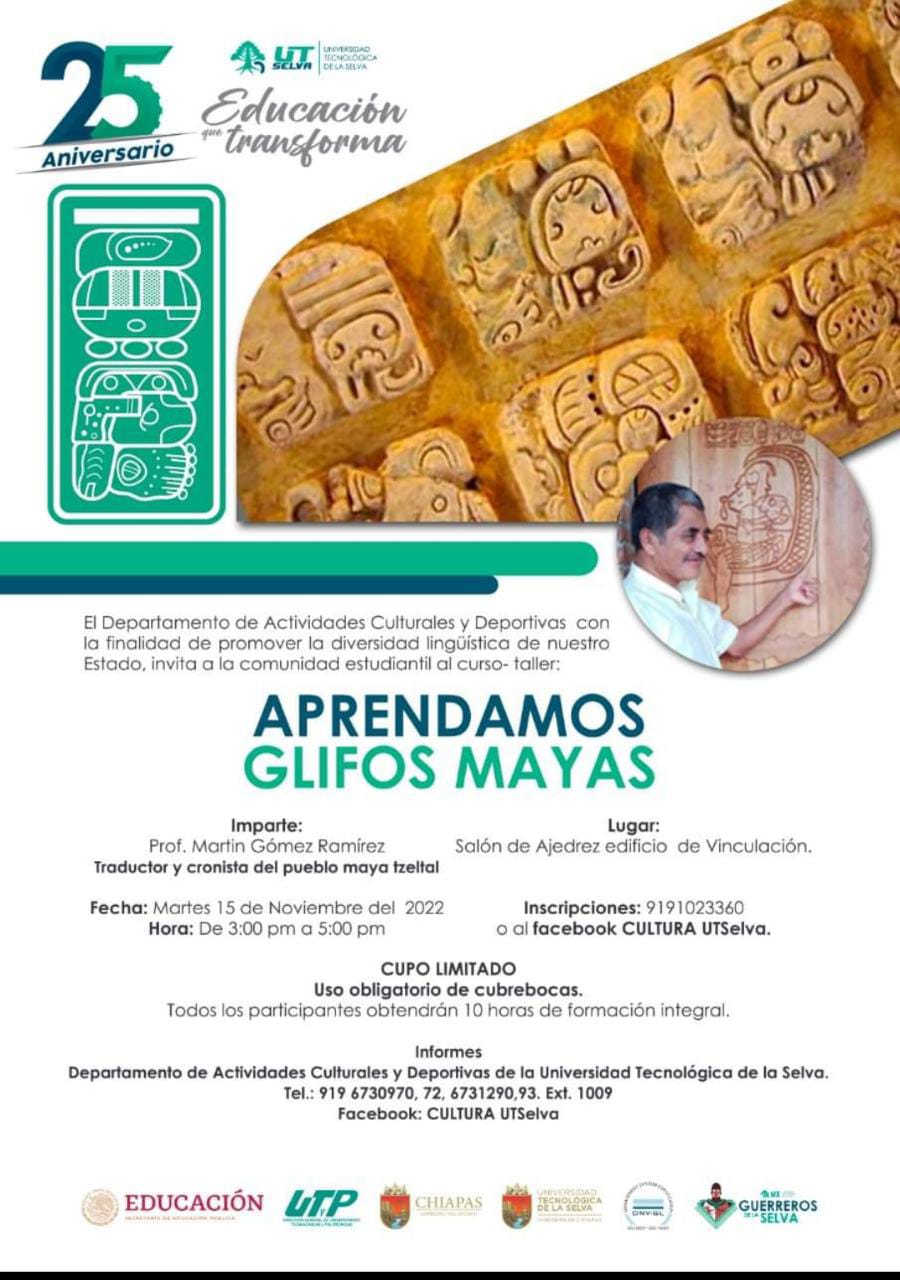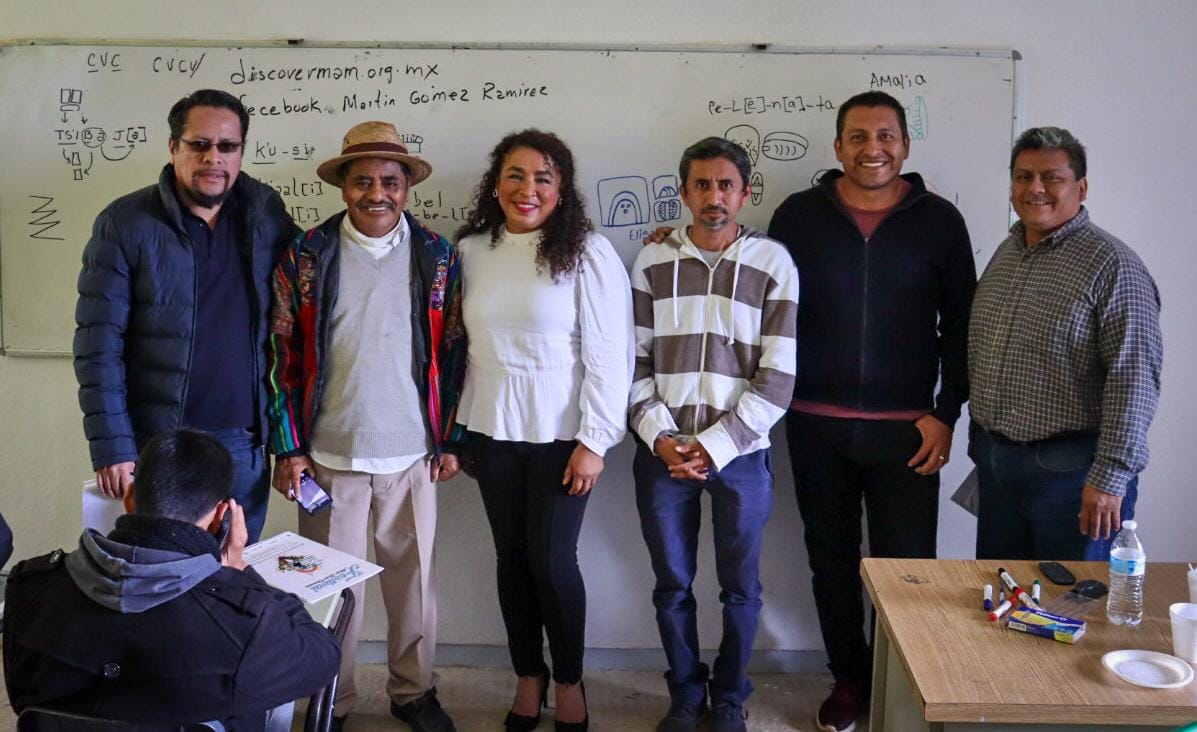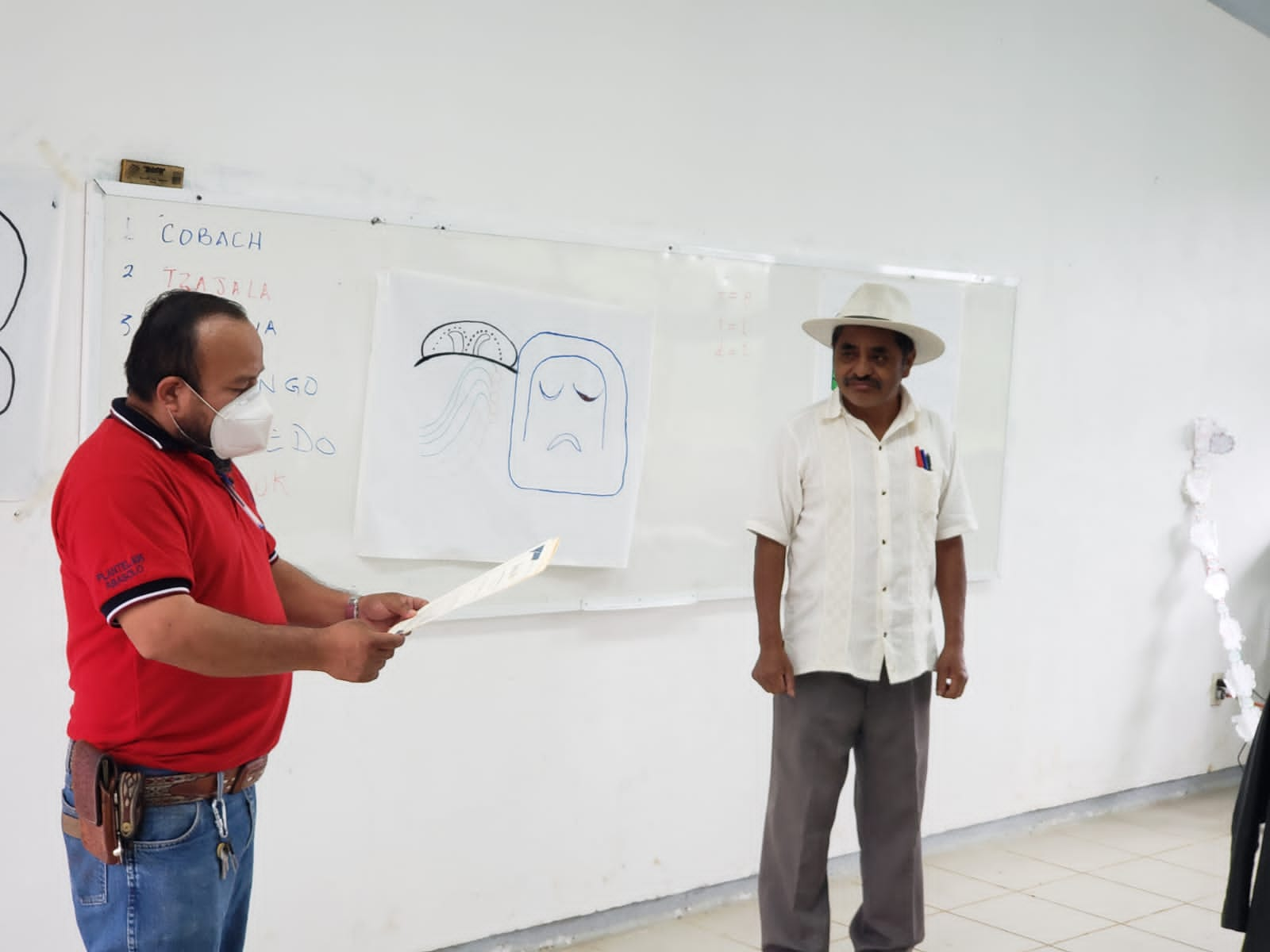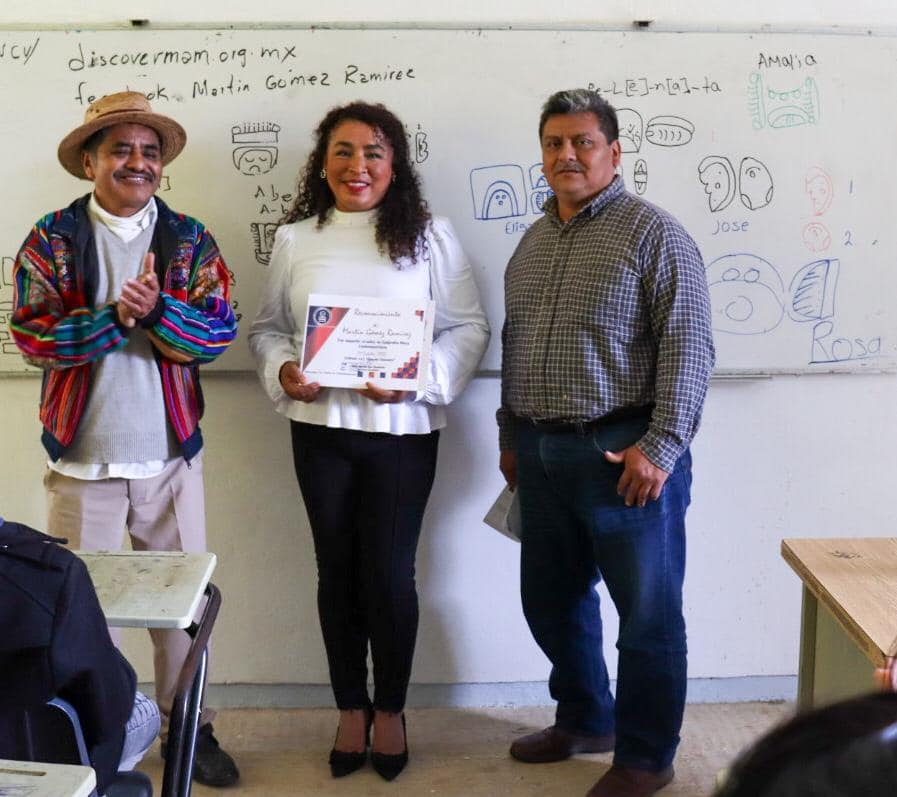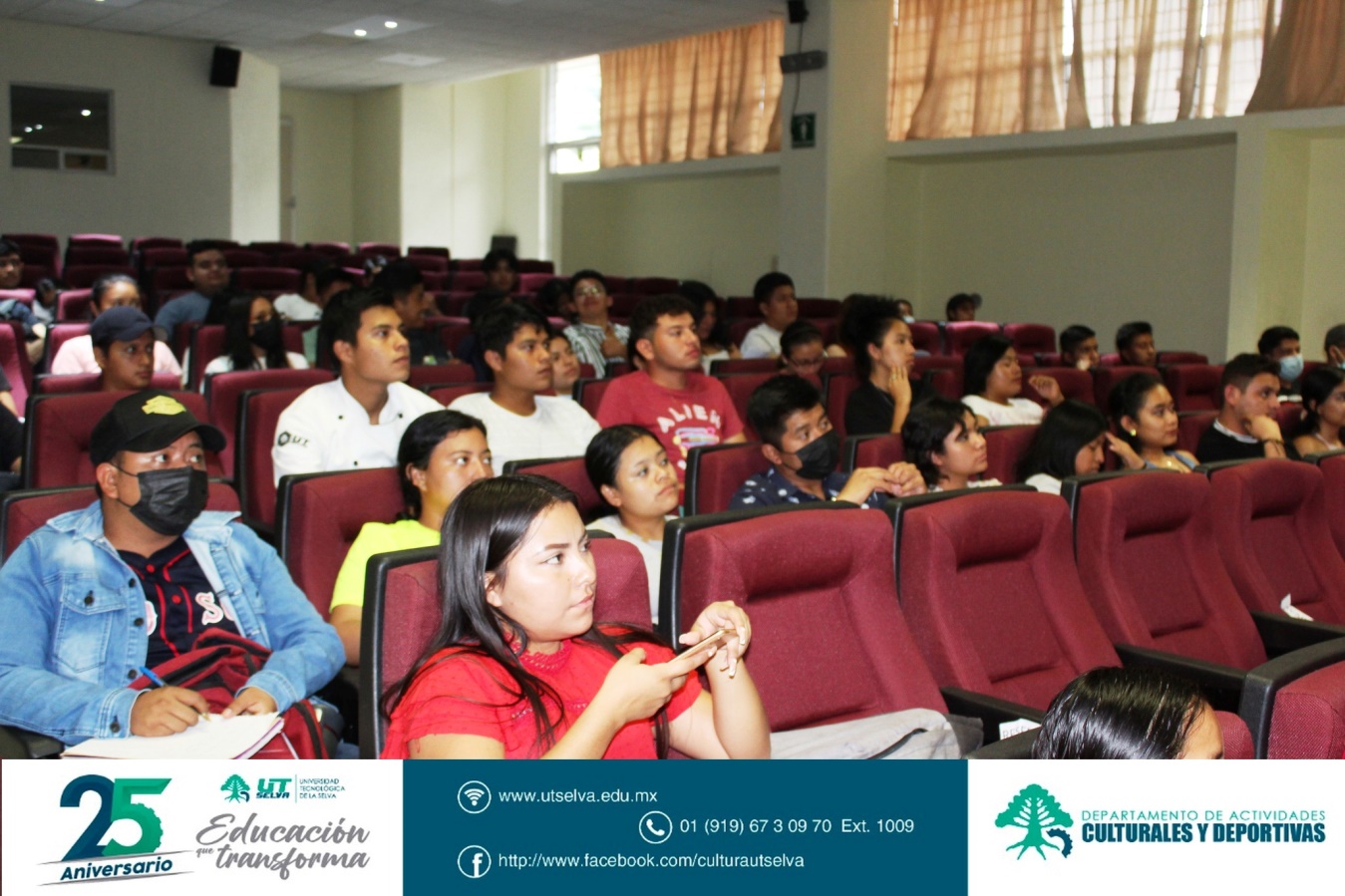
4 Ajaw 8 Mol: Drawing by Jorge Pérez de Lara
Participants gather in the lobby of the Hotel Rincon del Arco.
4 Ajaw 8 Mol (August 26, 2023)
Report from the Fifth International Congreso on Ojer Maya’ Tz’ib’ 2023
It has been quite a busy summer, and it is finally coming to an end. This month, we publish the formal report from Ajpub’ Pablo García Ixmatá, the Coordinator of the 5th International Congreso and our dear friend. We send Ajpub’ and his family our deepest condolences for the recent loss of his mother, Catarina Ixmatá Quiacaín. Ajpub’ kindly prepared this report for us during this difficult time. We are so grateful for all of the work he and the Congreso Team have done to help carry out such a successful and unforgettable event, and we wanted to thank all of you, our generous supporters, for everything you have done to help make this happen.
Maltyoox,
Michael J. Grofe, President
MAM
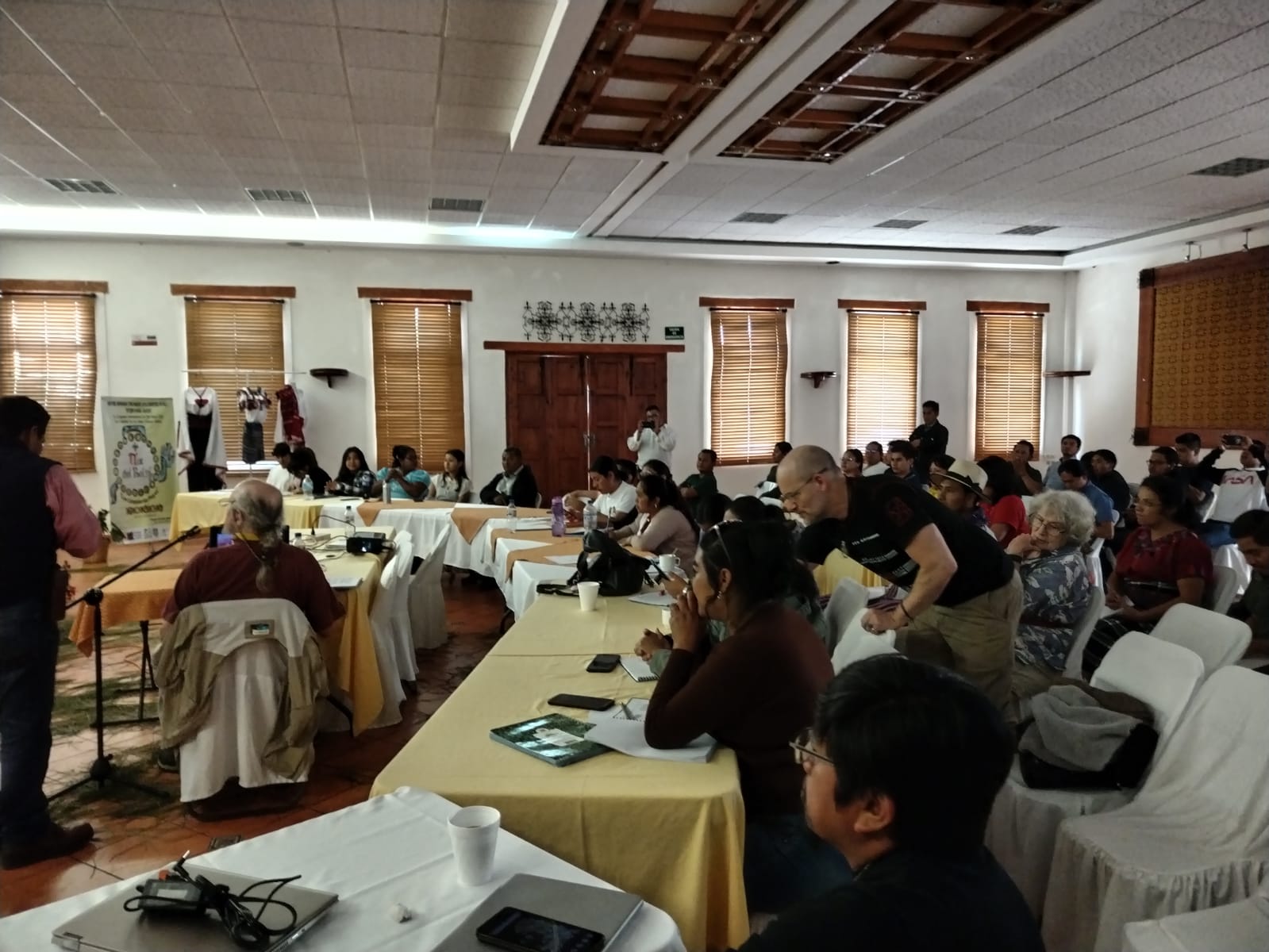
Gathering in the conference room to hear Nick Hopkins’ presentation
REPORT
SJO’IL NIWAN TSOMJEL B’A SNEB’JEL POKO TS’IJB’ANEL MAYA 2023
5th INTERNATIONAL CONGRESO ON OJER TZ’IB’ 2023
July 10 – 15, 2023
Hotel Rincón del Arco
San Cristóbal de Las Casas, Chiapas, México
The International Congreso on Ojer Tz’ib’ is an event that brings together Mayan speakers from different peoples of the current Mayan territory (Mesoamerica) who live in Mexico, Belize, Honduras, and Guatemala. The Congreso seeks for Mayan speakers to know and learn, in a critical way, the operation of the writing system, the historical texts produced through said system, and its contents. The initiative to hold International Congresos has been taking place for years through events held inside and outside Guatemala. The first event was held in 2010 in Antigua Guatemala, as a first approach between Mayan speakers to discuss topics of interest to them and to determine the way for them to organize and carry out events of this type. Also, these events are organized by MAM – Mayas for Ancient Mayan – since 2005, made up of researcher friends, mainly from the United States. Likewise, Ajtz’ib’ab, made up of a team of Mayan speakers with the collaboration of different people and public and private institutions that are related to the purposes of the Congresos.
The First International Congreso on Maya Epigraphy was held in the city of Valladolid, Yucatan, Mexico. Then, a second International Congreso was held at the Instituto Tecnológico de la Selva de Ocosingo in Chiapas. In 2016, the Third International Congreso was held in the Department of Petén, Guatemala, and the Fourth International Congreso was held in Huehuetenango, Guatemala. In each of these international Congresos, different training activities have been carried out, such as classroom sessions, workshops, magisterial conferences, cultural activities and guided tours of ancient cities.
The objective of the present congress was: “To develop the topic of Maya Calendars and the most recent studies to sensitize the participants towards critical thinking knowing our reality in the past, present and future. It also seeks to understand the functioning of the different calendars from the inscriptions of the Ojer tz’ib’, colonial documents and current use, their cycles, concepts, correlations, etc. from a critical perspective.”
The reasons why only Maya people are invited and invited to this Congreso?
Since the Spanish invasion and then colonization, the Maya population have been historically denied the knowledge of their ancient roots, as well as marginalized from formal education (educational centers from the primary level to the higher level, workshops, conferences), opportunities or scholarships. Above all, this is for Maya people to develop critical thinking in the process of resuming their linguistic and cultural roots. When they have had access to any information or training, it has typically been from a Western vision and from a folkloric point of view.
Maya academics and foreign friends who have contributed to the study of Ojer Maya’ Tz’ib’ are invited to develop workshops and give academic lectures or guided tours. Likewise, people are invited who have had teaching experience in different universities in other countries, or who speak or have serious studies in one or more Mayan languages.
Purpose of the 5th Congreso:
One of the purposes of this Congreso is to give continuity to the training that a good number of Mayan speakers have had in the 1st, 2nd, 3rd, and 4th Congresses held in Valladolid, Yucatán, Mexico (2012), Ocosingo, Chiapas, Mexico (2014), Petén, Guatemala (2016), and Huehuetenango, Guatemala (2018). Also, these Congresos give an opportunity to Mayan speakers who for the first time want to venture into learning the Ojer Tz’ib’ system.
For this 5th Congreso, the people who are selected were people who have taken advantage of previous training and showed their commitment to the promotion, dissemination and use of the system for writing/painting in the Mayan languages to which they belong, as well as their promotion, diffusion and development. The resources for the realization of this 5th Congreso are the result of the great efforts of people and institutions that collaborate for the organization and development of these Congresos, managed through the institution MAM-Mayas for Ancient Mayan.
Development of Activities
On July 10, 2023, the organizers of the SJO’IL NIWAN TSOMJEL B’A SNEB’JEL POKO TS’IJB’ANEL MAYA 2023 5th INTERNATIONAL CONGRESO ON OJER TZ’IB’ 2023 met to wait for national and international participants. This job of keeping up with arranging the furniture in the classrooms and buying bread and coffee, among other tasks, was resolved with the participation of all those involved.
The teachers involved did the logistical work and the purchase of candles, flowers of different colors, white, red, yellow and black corn, among other supplies that Maestro Nicolás Velasco Díaz would use to perform the ceremony on July 11 of this year, an act that celebrated from 8:30 a.m. to 9:00 a.m. and then continued with the order of the program established by all the participants.
All the participants who arrived until 9 pm on July 10 were supported with their respective lodgings at the “Hotel Rincón del Arco,” located at Calle Ejercito Nacional No. 66, Barrio el Cerrillo, San Cristóbal de Las Casas, Chiapas, Mexico. This support was carried out by all involved to provide security and good rest to all participants.
Lastly, the participants present got involved in doing what Nicolás Velasco Díaz directed, including everything related to the decorations that would take place on July 11, 2023, all to start without delay the rituals for opening ceremony.
On July 11, 2023, the organizers of the event met to begin with the starting flag for the events that would take place under the strict order of the program that each organizer, both national and international, had at hand.
At first, the participants moved to the indicated place where they would receive the meal that is scheduled for each day of the event, so the activities were developed under a protocol of both security and order for the proper development of the activities to avoid any program incident or mismatch. Then from 8:30 to 9:00 am, the ritual beginning of activities was carried out, and the participants went to be purified with basil, candles and posh (liquor), where the participants welcomed in this new experience. Immediately after, all of the participants moved to the conference room, where the panelists appeared at the presidium table and everyone presented themselves in the order in which they are on the program.
Second came the inaugural presentations from 10 to 11:30 am. Ajxol Hector R. Xol Choc gave the presentation “Maya Calendars: Two or Three Reflections to Consider for Their Study, Promotion and Dissemination.” Michael Grofe followed with “Yaxk ́in, the Solar Nadir and the Agricultural New Year in the Formation of the Haab Calendar.” Lastly, the Association Jolob Jlumaltik participated with: “Weaving Territories.”
After the break from 11:20 am to 11:30 am, the participants joined the classrooms, according to the workshops for which they were registered: Introductory, Intermediate or Advanced. The Introductory Workshop was led by Ajxol Héctor R. Xol Choc and Dr. Nicholas Hopkins; the Intermediate Workshop was led by Dr. Barbara MacLeod and Dr. Alejandro Sheseña Hernández; and the Advanced Workshop was led by Dr. Michael Grofe and Alexander Smurr-Ferrer.
All the activities were carried out responsibly according to schedules and the good interpersonal relationship of the workshop participants; none of the participants suffered from thirst and hunger.
On July 12, 2023, the organizers met for the event that would be developed under strict order of the program that each national and international organizer had at hand.
On July 12, all the participants met at 8:00 am to have breakfast and some coffee with bread prepared by the restaurant staff, where all the participants felt very well cared for. From 9:00 to 11:00 am the Introductory, Intermediate and Advanced workshops continued.
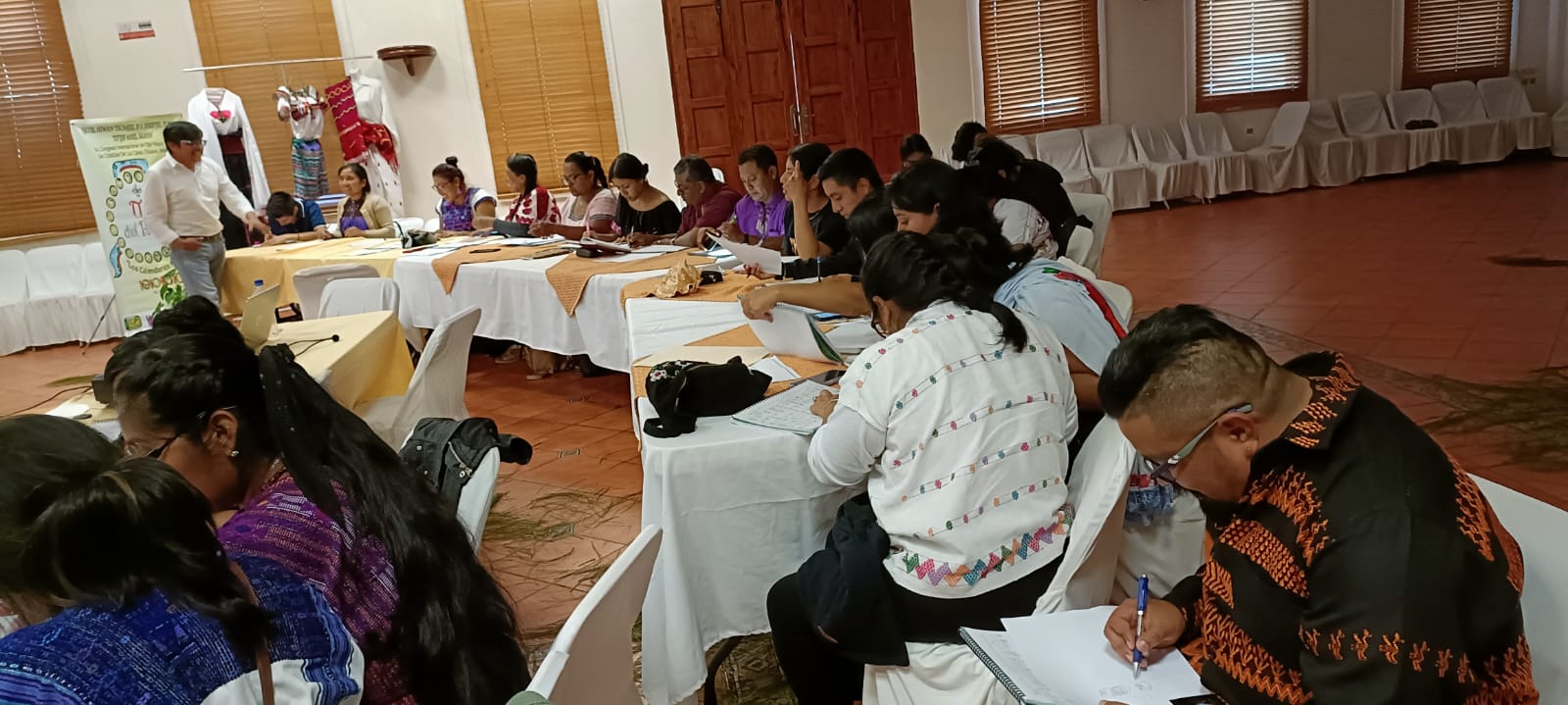
Participants in the Introductory workshop
In the introductory workshop, the workshop leaders, Ajxol Hector R. Xol Choc and Nicholas Hopkins, provided materials, white paper, and colored pencils, and they also used computers and projectors as didactic material to provide information to all participants. In this workshop everyone participated, they asked questions that arose since the workshop was carried out with comprehension exercises about reading and writing native languages. At all times there was camaraderie and respect for the achievement of objectives.
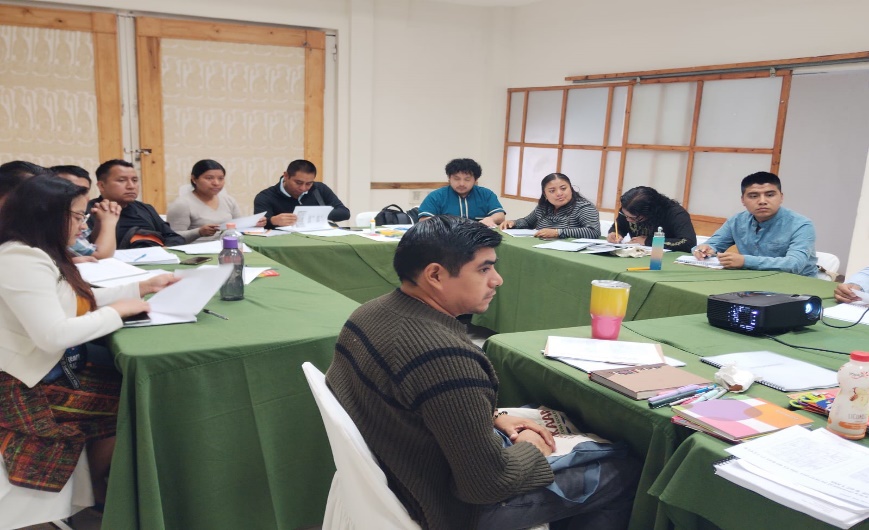
Participants in the Intermediate workshop
In the Intermediate workshop, the workshop leaders, Barbara MacLeod and Alejandro Sheseña Hernández, provided materials, including white paper, colored pencils, markers, and notebooks. They also made use of computers and a projector as didactic material to provide information to all the participants. In this workshop everyone participated both individually and in groups, they also asked questions that arose since the workshop was carried out with comprehension exercises about reading and writing native languages. All activities were presented with camaraderie and respect for the achievement of the objectives.
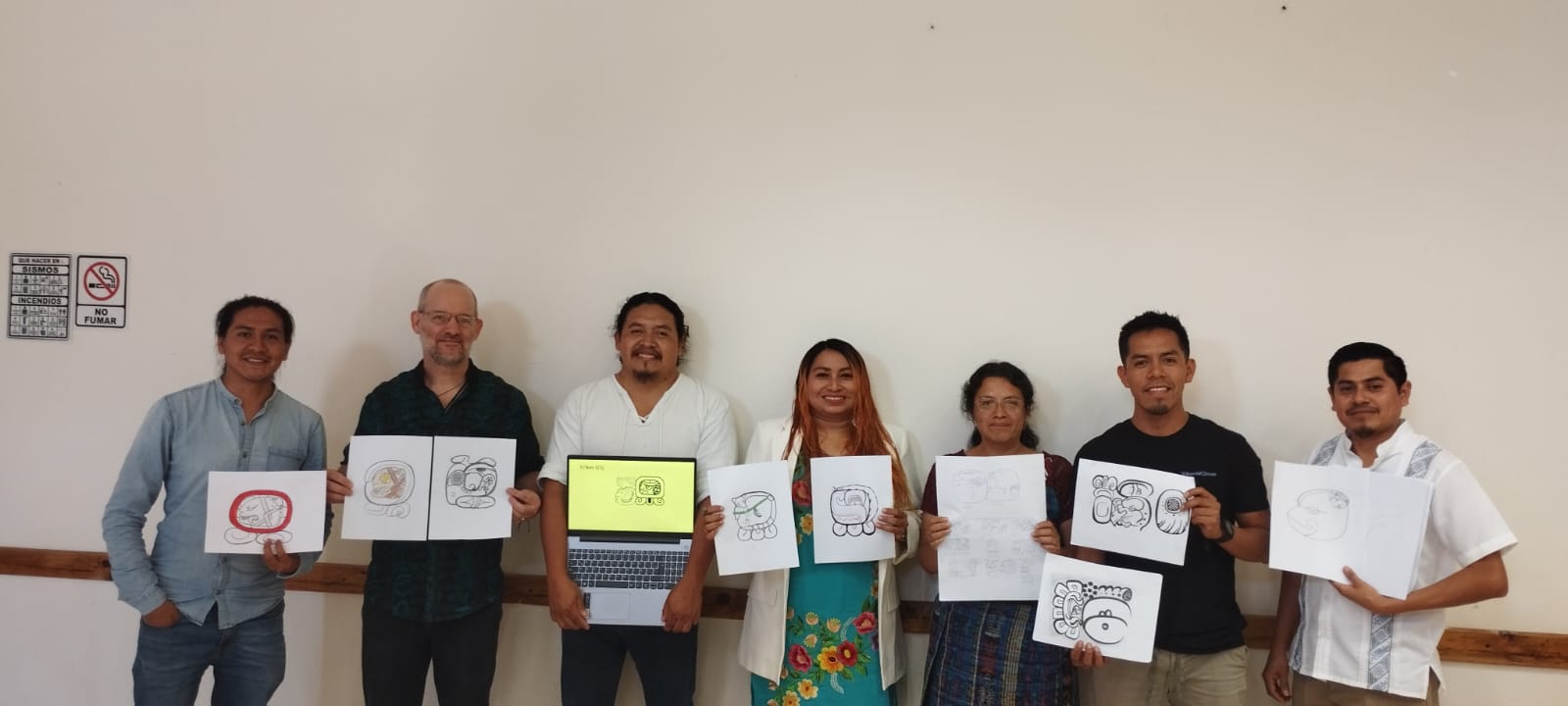
Participants in the Advanced workshop
In the Advanced workshop, the workshop leaders, Michael Grofe and Alexander Smurr-Ferrer, provided materials, white paper, colored pencils, and markers, and they also made use of computers and projector as teaching material to provide attention to all participants. In this workshop everyone participated both individually and in groups. Upon entering the work room, attendance was marked on a list that was attached to one side of the door of the room. All activities were presented with camaraderie and respect for the achievement of the objectives.
Throughout the development of the activities, the participants had freedom of mobility from one place to another. During the break time, everyone went to enjoy the coffee and bread that was partly outside the classrooms, and this service was sufficient on the part of the organizers, always taking care that the participants did not suffer from thirst and hunger.
I would also like to say that while the Introductory, Intermediate and Advanced workshops were taking place, there was a climate of respect and above all of camaraderie in commenting and expressing questions among colleagues, as well as with the persons in charge of sharing the workshop. Participation and a desire to share academically inside and outside the classrooms were observed at all times. Apart from lunch and dinner, the desire to share with colleagues was always apparent, and no adverse situations to the scheduled program or the proceedings took place.
On July 13, 2023, the organizers met for the event that would be developed under strict order of the program that each national and international organizer had at hand.
Continuing with our work program, I can report that the activities were carried out starting with breakfast for the participants in a timely manner without any incident to regret. On the contrary, all the necessary attention from the staff at the Hotel Rincón del Arco worked very well.
The activities began in the three workshops that were aimed at people in the three different levels: In the introductory workshop, the workshop leaders were Ajxol Héctor R. Xol Choc and Nicholas Hopkins. In this workshop everyone participated. They asked questions that arose since the workshop was carried out with comprehension exercises about reading and writing native languages. At all times there was camaraderie and respect for the achievement of objectives; in each of the activities they worked with numbers and deciphering glyphs starting with the
proper names, dates of birth among other information. It should be noted that at all times the participants were heard apart from the fact that we were all placed in a round table.
In the Intermediate workshop, the workshop facilitators Barbara MacLeod and Alejandro Sheseña Hernández, provided materials such as white paper, colored pencils, markers, and notebooks. They also made use of computers and a projector as didactic material to provide information to all the participants. In this workshop everyone participated both individually and in groups, they also asked the questions that arose since the workshop was carried out with comprehension exercises about reading and writing native languages. All activities were presented with camaraderie and respect for the achievement of the objectives, it was also observed that everyone participated in an academic climate to decipher glyphs using the workbooks.
In the Advanced workshop, the workshop facilitators Michael Grofe and Alexander Smurr-Ferrer, as always, provided different materials, including white paper, pencils, colors, and markers. They also used computers and a projector as didactic material to provide information to all participants. In this workshop everyone participated both individually and in groups, and to enter the work room, attendance was marked on a list that was posted at the entrance of the room; Finally, I want to tell you that the three groups of workshop participants and beneficiaries of these workshops were served with coffee and bread during the break, apart from the fact that at lunch and dinner they were kindly attended by the staff of the Hotel Rincón del Arco from the city of San Cristóbal de Las Casas, Chiapas.
On July 14, the three groups of workshops focused on putting into practice what they had learned with the workshops, and they organized in groups to present at the respective levels: Beginners, Intermediate, and Advanced. After the presentations, the closing ceremony took place in two parts. The first part was where the certificates were delivered to all the participants in the Beginner, Intermediate, and Advanced levels. These were delivered by the workshop leaders and organizers of the event, MAM, Ajtz’ib’ab’ and the Chiapas Team. The Tseltal musicians were present at the event, and they participated in the academic closing ceremony. The second part was the spiritual culmination carried out by the Zoque guides, in the place where the events began, with permission, where the culmination of the international event took place. On the 15th, all the participants returned to their communities and countries of origin.
Once, twice and three times thanks to MAM for one more event to continue promoting the knowledge and ancient knowledge of the Mayan people.
Sincerely,
Ajpub’ Pablo García
Coordinador General del 5º Congreso Internacional, 2023
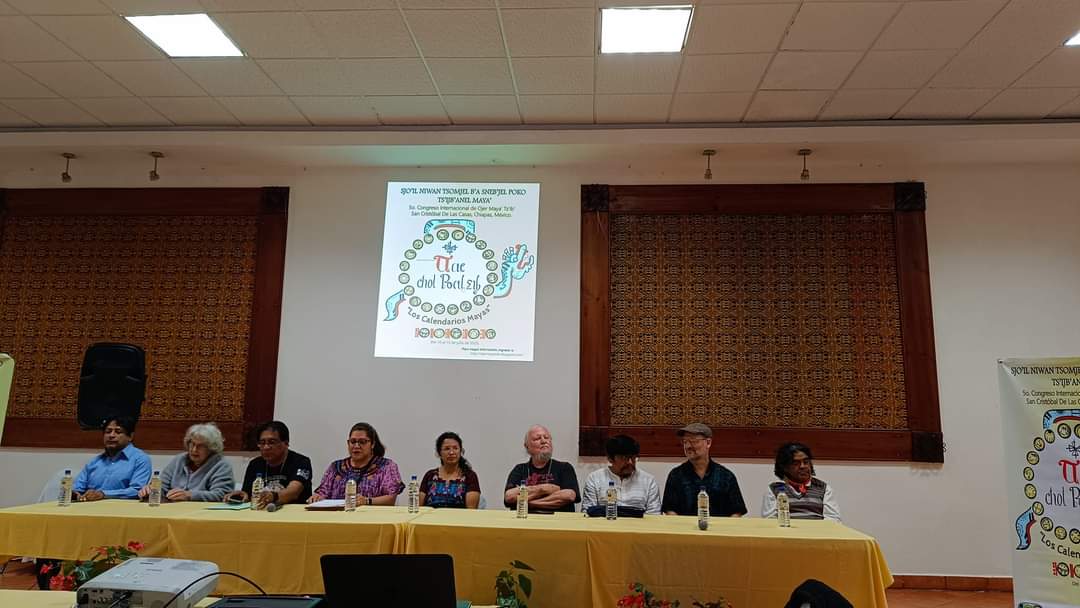
Panelists at the closing ceremonies

